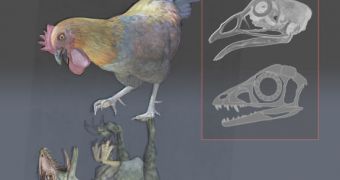Experts determined that birds are the living descendants of dinosaurs a long time ago, but they never really understood why the winged creatures appeared in the first place. A new study suggests that shifts in the evolution of dinosaurs are what prompted this entire group of species to develop.
Scientists from the University of Texas in Austin (UTA) and Harvard University collaborated with a number of other researchers on the new study, which focused on why birds display such a fast-moving biological clock.
While mammals take years to reach maturity, some bird species are capable of doing this within just 12 weeks, all while retaining the physical characteristics of baby dinosaurs, the research group explains.
One of the most interesting aspects of this study – which is detailed in the May 27 online issue of the top scientific journal Nature – is that it depicts evolution as a developmental phenomenon, which is something that has been rarely done before.
“By changing the developmental biology in early species, nature has produced the modern bird – an entirely new creature – and one that, with approximately 10,000 species, is today the most successful group of land vertebrates on the planet,” Harvard associate professor, Arkhat Abzhanov, says.
The expert, who was a coauthor on the new study, says that the conclusions this study reached are obvious to anyone who compares the skulls of dinosaurs and modern birds. There are, of course, numerous differences between the two groups as well.
For example, dinosaurs have very long snouts and many sharp teeth, whereas birds tend to have bigger brains, and much larger eyes. However, Abzhanov explains, there are also many similarities. In fact, the number of similitudes puzzled the research team.
“No one had told the big story of the evolution of the bird head before. There had been a number of smaller studies that focused on particular points of the anatomy, but no one had looked at the entire picture,” first study author and Harvard PhD student, Bhart-Anjan Bhullar, adds.
“What’s interesting is that when you do that, you see the origins of the features that make the bird head special lie deep in the history of the evolution of Archosaurs, a group of animals that were the dominant, meat-eating animals for millions of years,” he goes on to say.
In order to assess how the bird skull changed shape over millions of years, researchers used UTA and Harvard computed tomography (CT) scanners to create virtual models of dozens of heads, from theropods and ancient dinosaurs to modern birds.
An interesting aspect of the research was that the skulls of birds display very few changes from infancy to adulthood, whereas the skulls of dinosaurs changed considerably over the years.
“That you can have such dramatic success simply by changing the relative timing of events in a creature’s development is remarkable,” Abzhanov says.
“We now understand the relationship between birds and dinosaurs that much better, and we can say that, when we look at birds, we are actually looking at juvenile dinosaurs,” he concludes.

 14 DAY TRIAL //
14 DAY TRIAL //